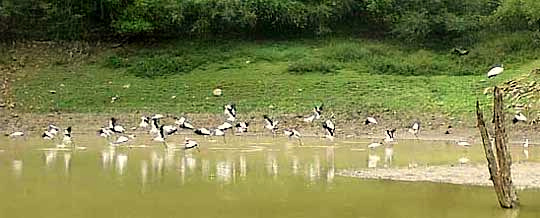Excerpts from Jim Conrad's
Naturalist Newsletter
from the June 29, 2007 Newsletter issued from Sierra Gorda Biosphere Reserve, QUERÉTARO, MÉXICO
WANDERING WOOD STORKS
When the rain ended a couple of hours later I packed up, walked around the corner, and there was a flock of Wood Storks feeding in shallow water next to a mudflat. You can see the very ones, with several smaller, white, immature Little Blue Herons over at the right, below:

You can see Wood Storks at www.backyardnature.net/mexnat/woodstrk.htm.
These are fairly big birds, with wingspans of over five feet. I'd seen occasional Wood Storks at the reservoir before but never in such numbers. The picture shows only part of them; later a flock of about 40 birds flew by. Probably the reason they're not here most of the year is the lack of habitat. Only when the reservoir's water is very low, with lots of level mud exposed, can they forage the way they like to, wading in shallow water and probing with their long beaks.
You can't look at a stork without thinking "primitive." Especially because of the black, featherless head and neck you can almost feel the dinosaur in them. I grew up with the notion that storks were presented early in field guides because they were among the first bird- groups to evolve, while perching birds appeared in the field guide's backs because they're so recently evolved. This concept has changed.
One current idea of the "Bird Evolutionary Tree" is at http://www.explorebiodiversity.com/BIRDS/BirdsofWorld/Systematics.htm.
"Evolutionary trees" such as the above give us an idea of the path evolution took as the various bird groups arose. Such trees are based on the assumption that "the more genes two taxa share, the more closely related the taxa are."
Another assumption about evolutionary trees is that the fewer branches occurring between the tree's root and a final group of organisms at the end of a branch, the more primitive that group is. A group appearing only after many branchings is regarded as having arisen relatively recently. For this to be true in all cases it's necessary for evolution to have proceeded at a constant rate across all taxa. That's not necessarily the case, however, so trees such as the one shown above must be regarded as only good guesses.
Remembering the limitations, then, the above tree suggests that kiwis, ostriches, ducks and woodpeckers are relatively primitive, but pelicans and loons, our storks, herons, ibises and spoonbills, no mater how primitive they may look, are actually pretty modern. Perching birds, or Passeriforms, appear near the middle of the tree, so that group is neither particularly primitive nor modern.
If you'd like to understand evolutionary trees better, a great place to learn the basics is at Berkeley's http://evolution.berkeley.edu/evolibrary/article/phylogenetics_01.